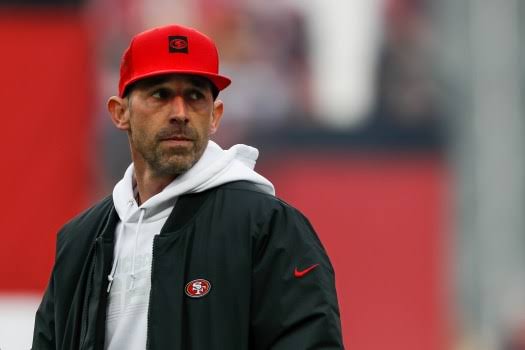
Kyle Shanahan: Reasons Why I Called a Run for WR Jauan Jennings.
In the 49ers’ playoff victory against the Packers, the most unusual play occurred at the start of the second half. With Deebo Samuel sidelined due to a shoulder injury, wide receiver Jauan Jennings unexpectedly took on the running back role. Despite the initial confusion of this play, the 49ers emerged victorious. Grant Cohn sought an explanation from Coach Kyle Shanahan post-game, questioning the unconventional decision to call a run for Jennings in that particular situation.
During the 49ers’ playoff triumph against the Packers, the most peculiar moment unfolded in the opening play of the second half. With star player Deebo Samuel sidelined due to a shoulder injury, wide receiver Jauan Jennings found himself unexpectedly in the running back position. Although the play initially resulted in a yard loss, the 49ers ultimately secured the victory. Grant Cohn, curious about the unconventional decision, inquired post-game from Coach Kyle Shanahan about the reasoning behind calling that specific play for Jennings.
Shanahan responded with a grin, acknowledging the challenge of calling plays when unforeseen circumstances arise, such as a player being substituted unexpectedly. He hinted at the complexity of the situation, mentioning a “wristband number” – a coded play-call system used by teams. In essence, it appears there was a miscommunication or oversight in conveying the complete play call over the headset. Shanahan’s comment about forgetting to instruct against reading “Hessi” suggests a desire for a different play variation, one that didn’t involve Jennings in the running back role.
In sports terms, Shanahan’s explanation reveals the intricacies and potential hiccups in the communication of play calls, highlighting the challenges coaches face when adapting to unexpected player substitutions and the reliance on coded systems like wristband numbers.
Kyle Shanahan is renowned for his verbose and elaborate play calls, a distinctive aspect of his coaching style. Typically, teams resort to using coded numbers for plays in noisy away game environments to simplify communication, but the 49ers were playing at home during this instance. Moreover, considering they had just gone through halftime, a period conducive to scripting plays, the decision to rely on a numerical code instead of a detailed play description raises eyebrows. The complexity of Shanahan’s play-calling strategy comes into focus, prompting questions about the communication breakdown and the unexpected utilization of a specific play with Jauan Jennings in the running back position. In NFL, this scenario underscores the intricacies coaches face in adapting their strategies and play calls, even in familiar home game settings. The use of coded numbers, normally associated with mitigating communication challenges on the road, adds an intriguing layer to the post-halftime play that left fans and analysts puzzled.
You may also like
Related
Archives
Calendar
| M | T | W | T | F | S | S |
|---|---|---|---|---|---|---|
| 1 | 2 | 3 | 4 | 5 | 6 | 7 |
| 8 | 9 | 10 | 11 | 12 | 13 | 14 |
| 15 | 16 | 17 | 18 | 19 | 20 | 21 |
| 22 | 23 | 24 | 25 | 26 | 27 | 28 |
| 29 | 30 | 31 | ||||
Categories
- 2024 Australian Open
- 49
- 49ERS
- 49ers vs Lions
- 49ers vs. Chiefs
- 69ERS
- AFL
- AFLW
- American Football
- anonymous
- Arsenal
- Aston Villa
- AUSX 2024
- AUSX OPEN
- Baltimore Ravens
- Baseball
- Basketball
- Billionaires
- blog
- Books
- Boston Celtics
- Boxing
- Brisbane Bronco
- Buffalo Bills
- Canadian Football league
- Car Racing
- Caroline Panthers
- Celtics
- Championship
- Chelsea
- Chess
- Crystal Palace
- Cycling
- Dallas Cowboys
- Dallas Mavericks
- Dirt bike
- Djokovic
- Dodgers
- Dortmund
- Essendon Bombers
- Florida gators
- Football
- Fremantle Dockers
- Fullham
- general
- German Masters
- Giants pride
- Golden State Warriors
- Golf
- Hockey
- Houston Texans
- Indiana Fever
- Indiana Pacers
- Ipswich
- Ipswich Town
- Kansas city chiefs
- KYLE LARSON
- Lakers
- Larry bird
- LIFE STYLE
- LIFESTYLE
- Liverpool
- Los Angeles Dodgers
- Los Angeles Rams
- Mallas Cowboys
- Manchester city
- Manchester United
- Michealan Wolverines
- Michigan wolverine
- Michigan Wolverines
- Milwaukee brewers
- MLB
- MLB Aaron judge
- Motocross
- MotoGP
- Motorcross
- Music
- MXGP
- NASCAR
- NBA
- New England Patriots
- New Orleans pelicans
- Newcastle United
- NFC Championship
- NFL
- NFL Trade
- NHL
- Nottingham Forest
- Oil and Gas
- Olympic
- other
- Other Sports
- OU Softball
- PGA
- Philadelphia Eagles
- Philadelphia Flyers
- Philadelphia Phillies
- Pittsburgh Steelers
- Playoffs
- Racing
- Ravens smith
- Real Madrid
- Rugby
- San Francisco Fiants
- San Francisco Giants
- SEAL Team
- sevila
- Snooker
- Snooker Masters
- Sports
- St. Louis Cardinals
- Super Bowl LVIII
- Superbowl
- Supercross
- Ted Lasso
- Tennis
- TONY STEWART
- Toronto Raptors
- Tottenham Hotspur
- Tour de France
- Transfer News
- Uncategorized
- Video Games
- West ham
- Winnipeg Blue Bombers
- Wrexham
- WWE
Leave a Reply